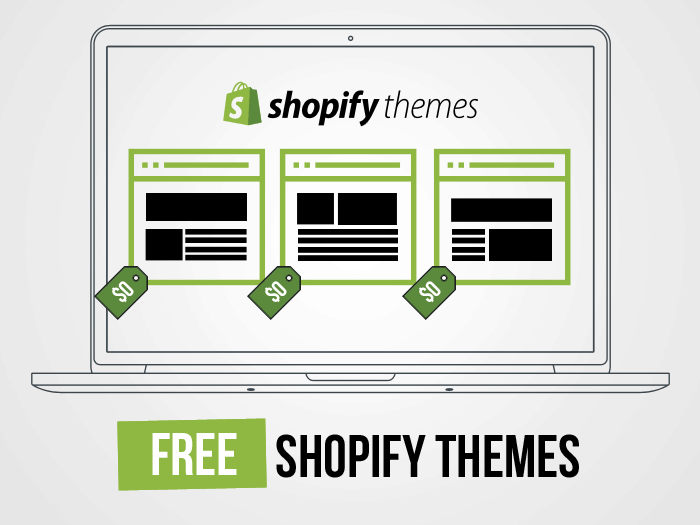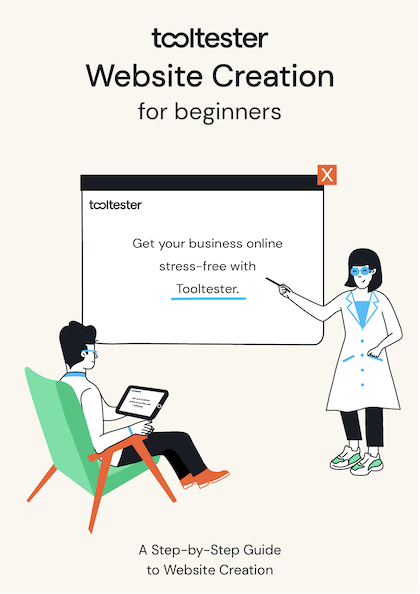Tooltester is supported by readers like yourself. We may earn an affiliate commission when you purchase through our links, which enables us to offer our research for free.
So, you’ve just signed up for Shopify and you want to start creating your perfect online store! One of the first (and most exciting) things you’re probably thinking about is: how is it going to look?
Well, that depends on which Shopify theme you choose for your store. There are hundreds of different themes, boasting endless different designs and features. They also range in price from over $300 down to nothing.
Yes, that’s right: you don’t have to pay a cent for your Shopify theme! And I’ve picked out 12 of the best free Shopify themes available in 2022 for you below.
But first let’s look at what a Shopify theme is, why it’s important, paid vs free themes, and how to choose the right one for your store.
What is a Shopify theme?
A Shopify theme is a set of templates that you apply to your online store, to control the whole “look and feel” of the website. Each theme has specific layouts, color schemes, fonts, navigation systems and other features.
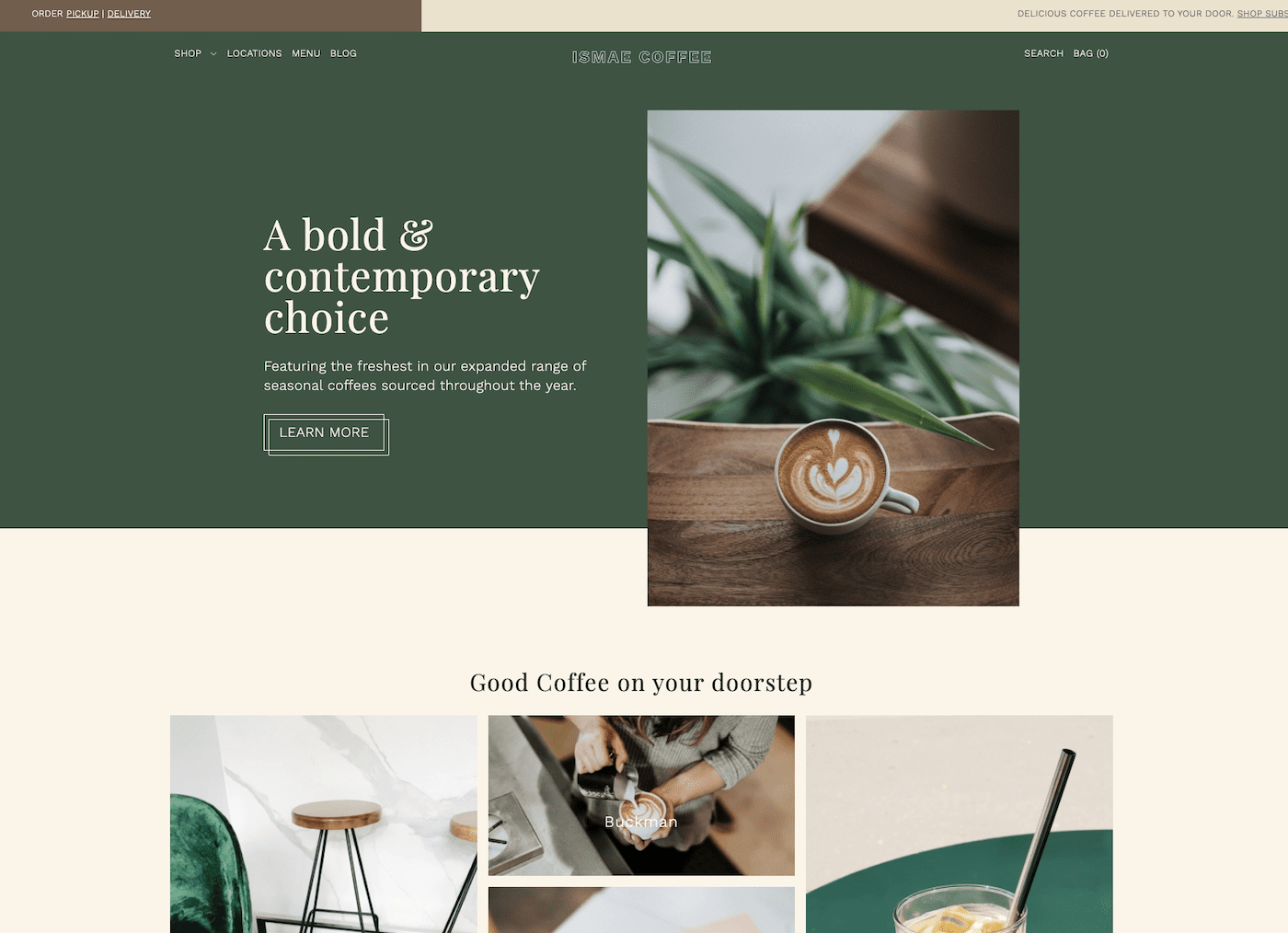
A Shopify theme determines the design and UX of your store
So, a Shopify theme essentially determines both the visual design and the user experience (UX), of your Shopify store.
Although each theme will come with these predetermined stylistic settings, you can always make changes to them. Either through the online editor provided by Shopify, or you can even edit the code directly yourself!
However, it’s always better to choose the Shopify theme that already most closely matches your vision for how your store should look and feel, to avoid as much unnecessary tweaking as possible.
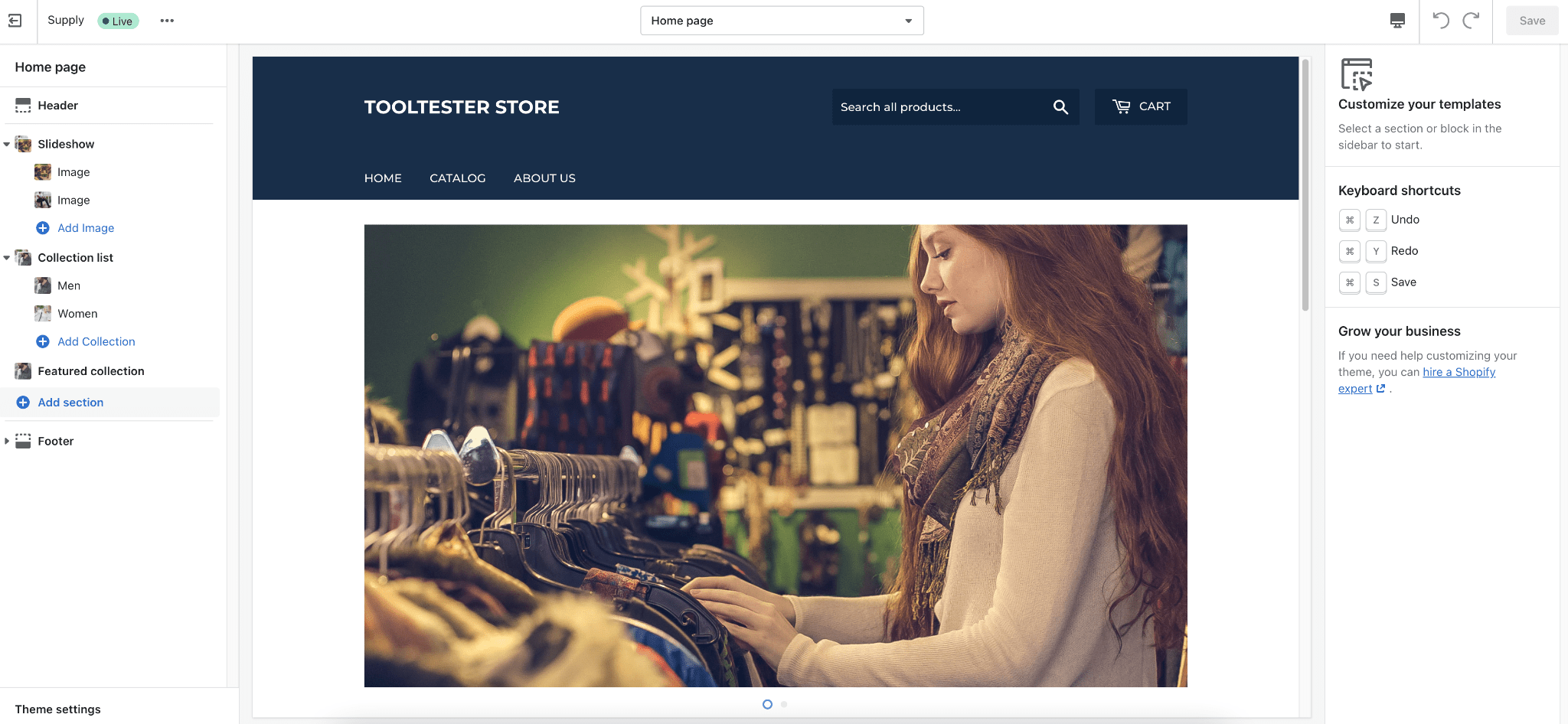
You can tweak your theme with the Shopify editor
Why is your Shopify Theme Important?
Your website design represents your brand, so it’s obviously important to choose a Shopify theme that chimes with your own vision and your customer’s expectations of your business.
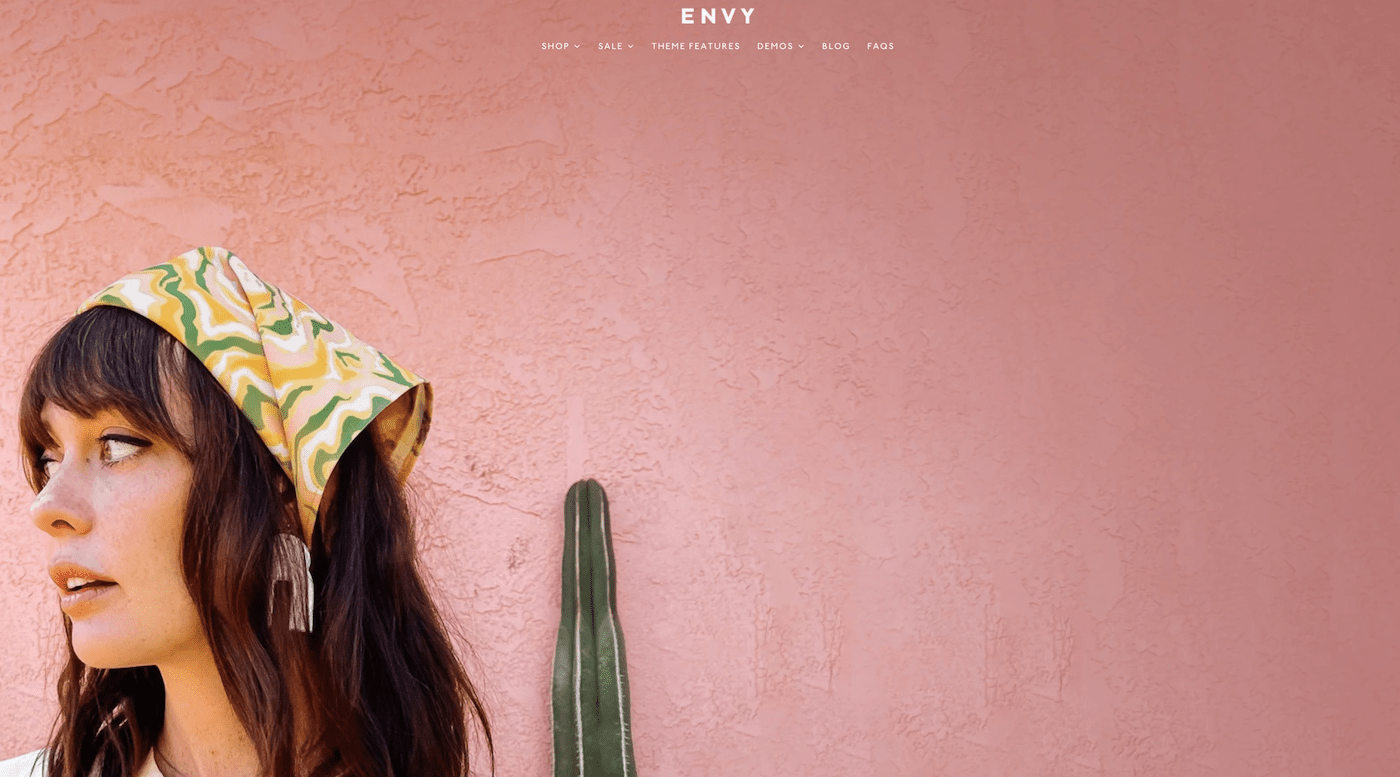
A Shopify theme is much more than just your brand
But your theme also determines your website’s user experience, its accessibility, and its technical on-page SEO (Search Engine Optimization). These factors will affect both your conversion rates and how well your website ranks in the search engines.
So, your Shopify theme has a lot of responsibility!
With the right theme, Shopify is pretty good for SEO and can provide a rich and fully accessible user experience.
But you’ve got to choose a good theme!
Free vs Paid Shopify Themes
There are 91 themes in the Shopify Theme Store. Of those 91 themes, you will need to pay to use 74 of them (prices range from $150 – $350). But 17 of them are completely free.
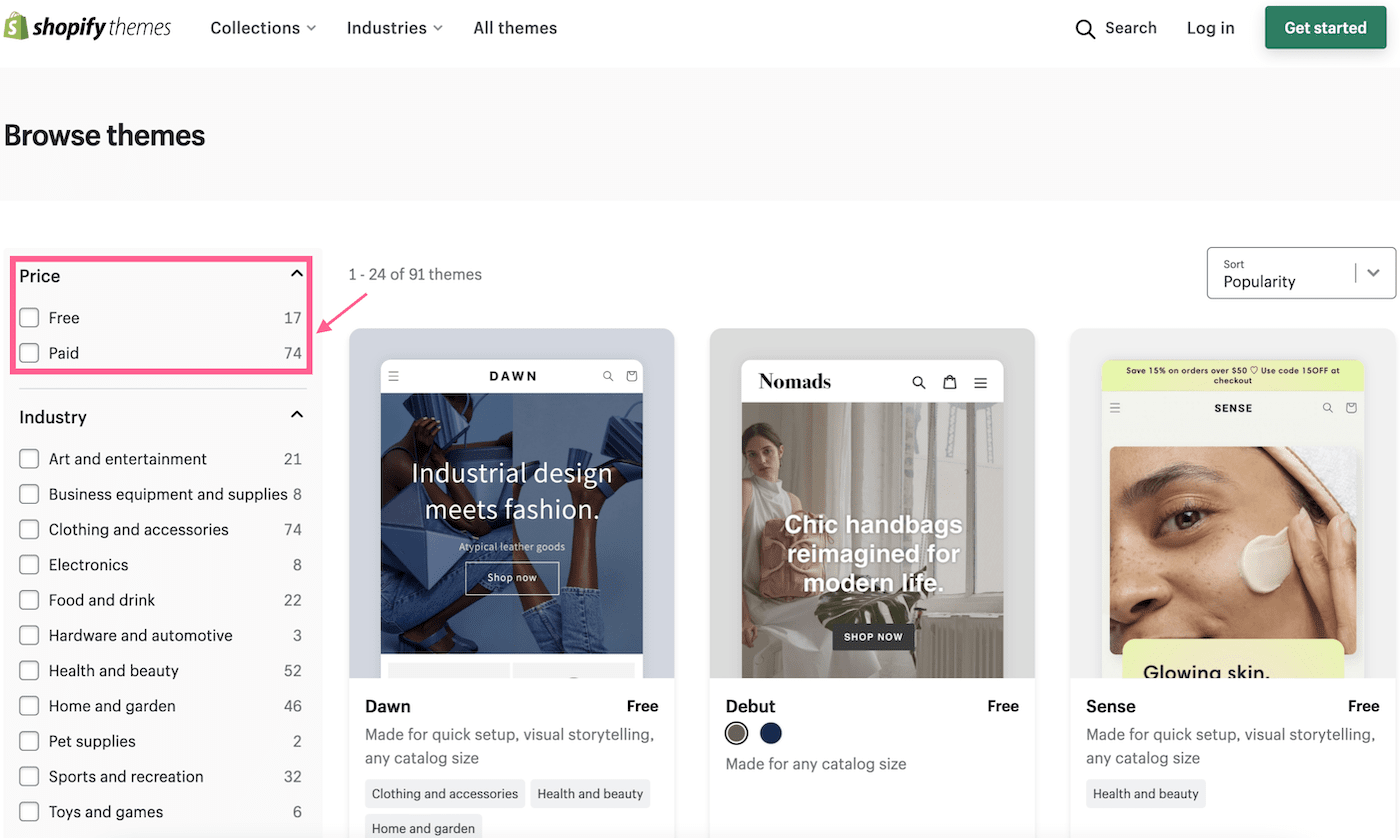
There are free and paid options in the Shopify Theme Store
Now, you’re probably wondering: if there’s a large selection of free Shopify themes, then why would anyone pay for a premium Shopify theme?
Well, the truth is, there are a number of reasons to choose a paid Shopify theme over a free theme:
- You get more ecommerce features
- You get more design features
- You get a more exclusive design overall
- You get a wider selection of themes to choose from
However, there are also a load of reasons to choose a free Shopify theme over a paid theme:
- It often loads faster (because it has fewer features)
- It’s often easier to use (because it has fewer features)
- You get the same level of customer support from Shopify
- It’s free!
So, if you’re on a limited budget, you like the designs, and the features you require are provided by the unpaid themes, then a free Shopify theme can be a great choice for your online store!
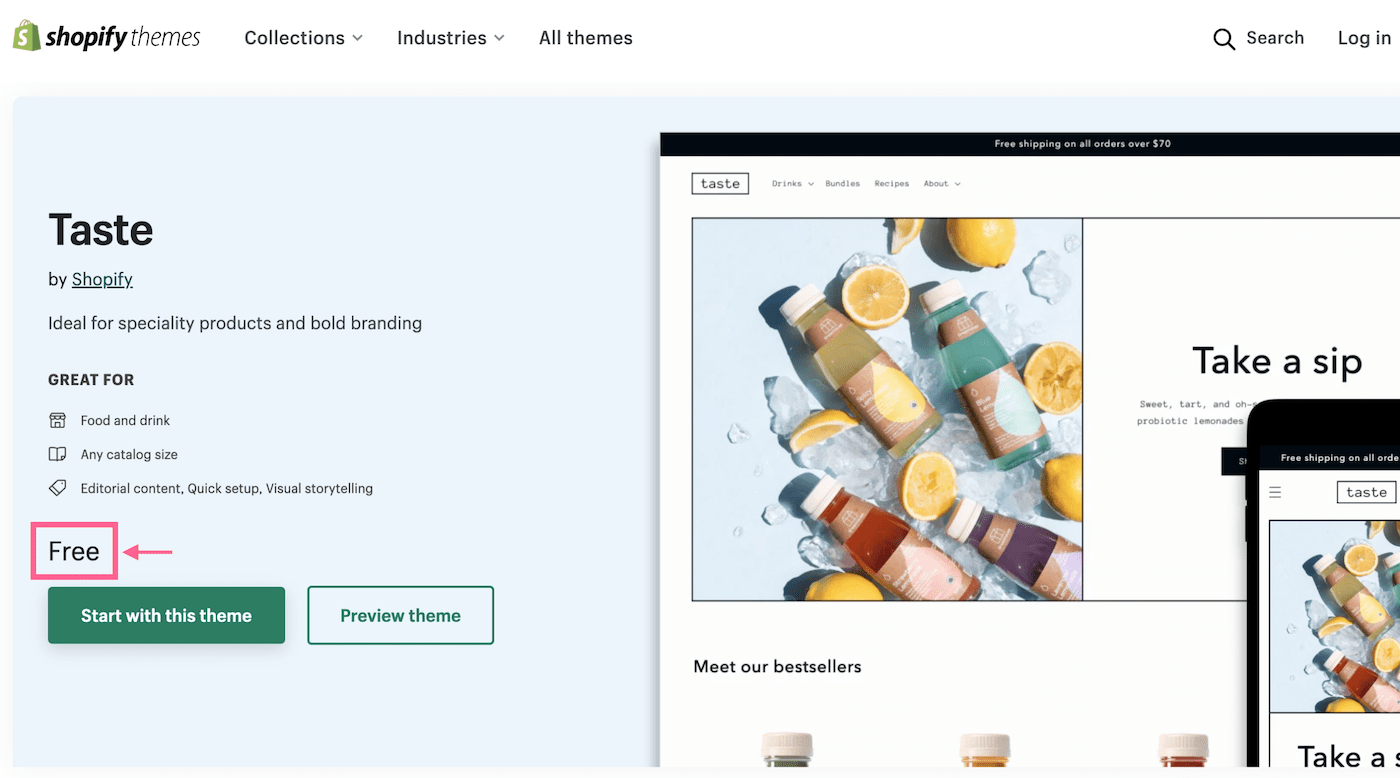
Taste: A great free Shopify theme
But how do you decide which one to use? Well, there are a few things to look out for when you’re choosing a free Shopify theme.
How to choose a free Shopify theme
Apart from a couple of differences, the process of choosing a free Shopify theme is actually much the same as choosing a paid Shopify theme! Let’s take a look at the most important considerations.
1. Check out the Shopify Theme Store first
You can get your free theme from the official Shopify Theme Store, from different theme marketplace, or directly from a third party developer.
In the Shopify Theme Store, not all the themes are developed by Shopify themselves. Many have been created by third party developers. However, all the themes in the theme store have been vetted by Shopify themselves.
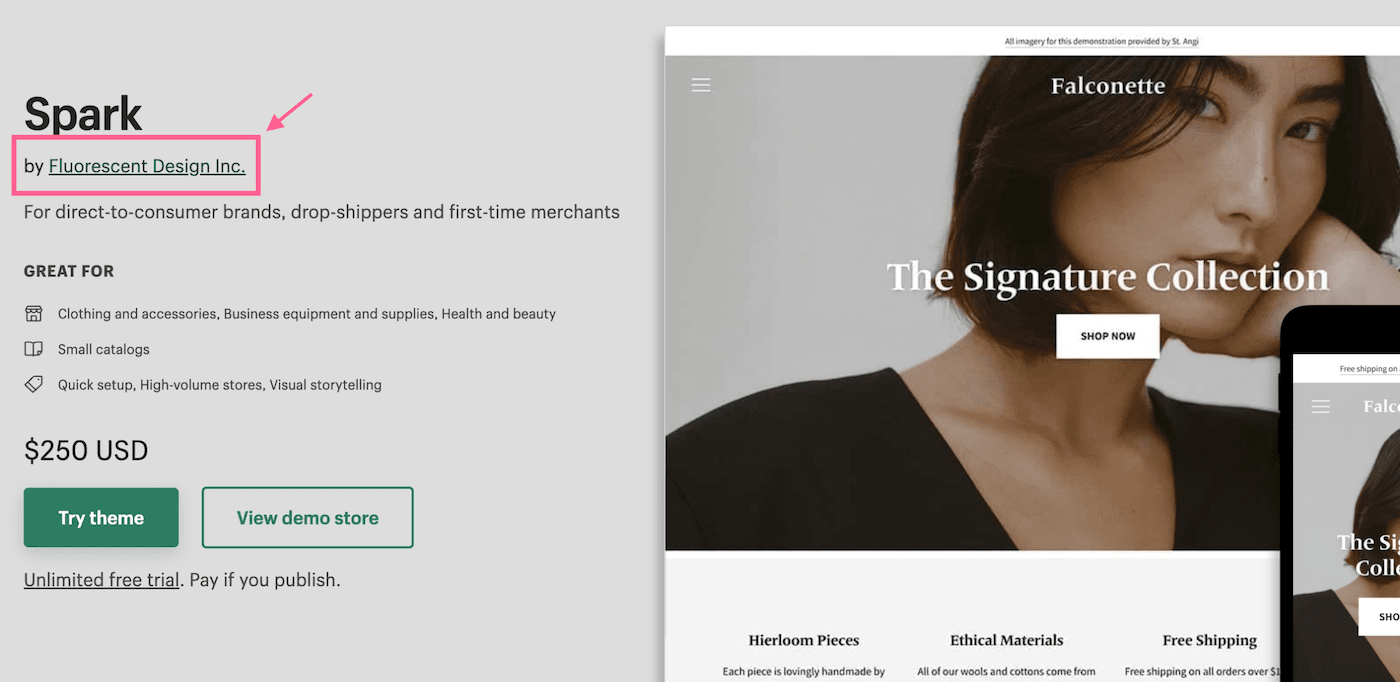
Many of the themes in the Shopify Store are developed by third parties
This means you are guaranteed a high level of quality: extensive features, fast loading and responsive design, robust security, regular updates, and support from Shopify themselves.
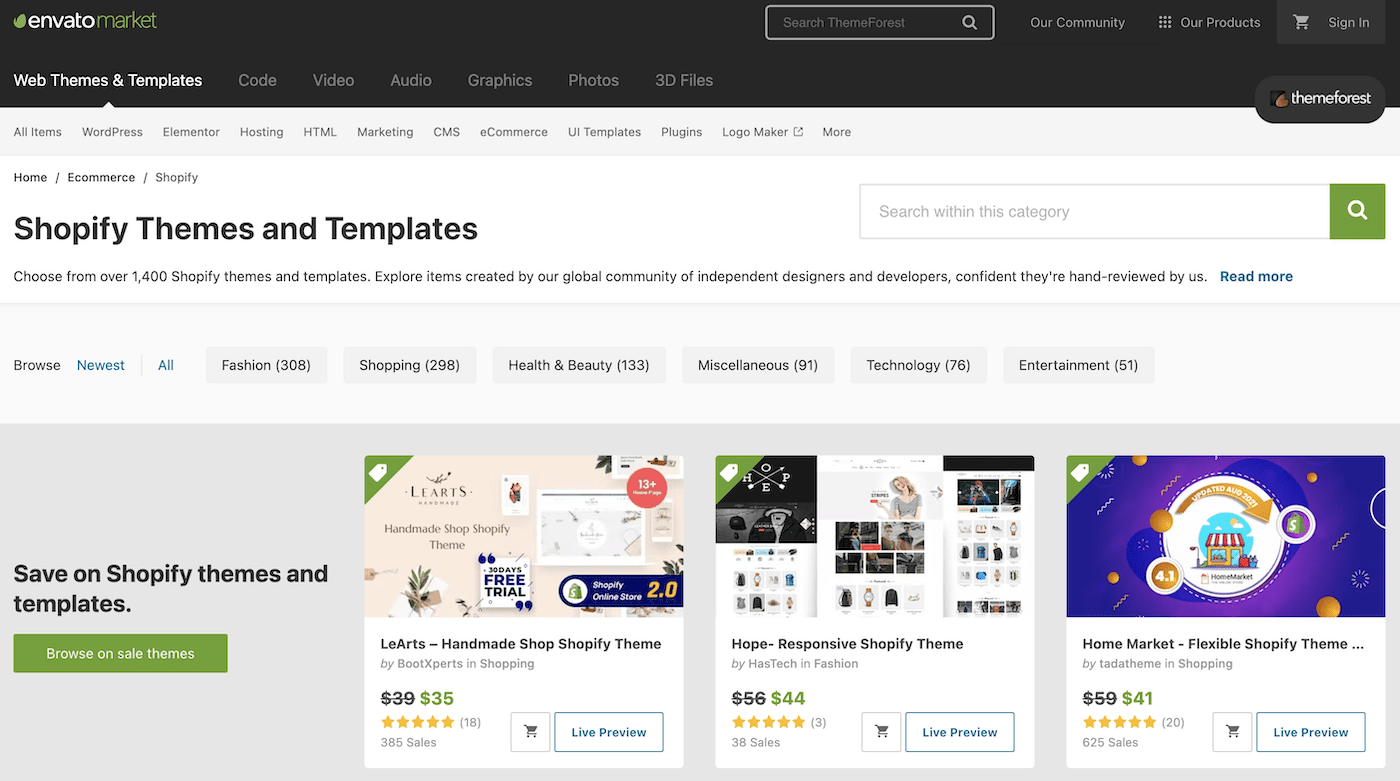
Envato Theme Marketplace
You don’t have to get your theme from the Shopify Theme Store, though. There are plenty of free options available directly from third party developers or other marketplaces (e.g. Envato). However, I would advise some caution here.
You may not get the same level of quality that you’ll get from the themes in the Shopify Theme Store. And these other free themes may be reduced in functionality deliberately, to encourage you to upgrade to a paid version.
For this reason, unless you require some specific functionality that’s not available from the themes in the Shopify Store, I would generally advise you get your free theme from there!
2. Decide which features are essential for your store
Different Shopify themes come with different features. And according to your business needs, you’ll probably require a specific set of features to provide the necessary functionality for your store.
For example, such features might be:
- A sticky navigation bar
- A grid based product display
- An integrated Instagram feed
- Parallax scrolling!
You can of course add specific features to any theme, either through the use of an app or through the work of a developer.
But this will generally cost time and money. So it’s always better to find a theme that at least provides the majority of the features and functionality you require.

Check the features list for the ones you need!
How do you make sure a theme has the features you need?
There will be a list of the specific features that the theme offers in the store. And you can usually check out some of those features in a demo store from the theme page. You can also usually filter themes by niche (because specific niches tend to require common features).
Be aware that although they have all the basics covered, the free themes won’t generally offer the same range of features as the paid themes. If your requirements are very particular, you might need to pay!
It’s a shame that the Shopify Theme Store doesn’t provide links to examples of live websites using specific themes, to help you see the various features and functionality working in real life.
Luckily for you though, we do where we can (see below)!
3. Choose a design that matches your brand and your customers expectations
You will no doubt have very clear ideas about the sort of design that best represents your own vision of your brand!
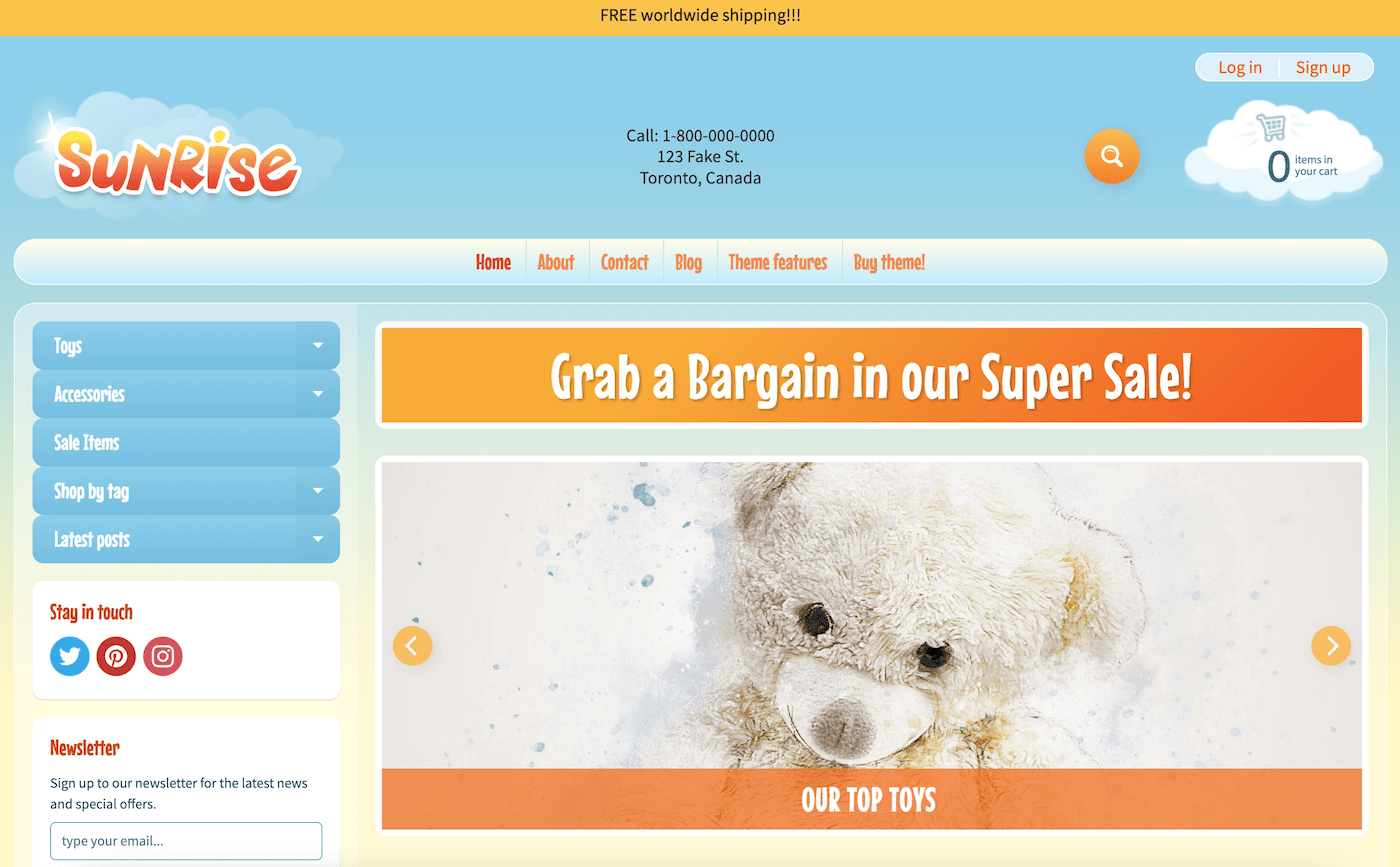
Make sure the theme design matches your brand and your customers expectations!
It’s important that the theme you choose not only matches this vision, but also matches your customer’s expectations, based on their consumer profile (interests, demographics, buying patterns etc.).
According to research, 38% of people will leave a website if they find the content or layout unattractive. So it’s important that you know what your customers are looking for, and your theme meets those expectations.
Again, the limited number of free themes (compared to paid themes), means you will have less choice over your design if you don’t pay. However, don’t forget that you will be able to customize your theme.
Which brings us to…
What makes a great Shopify Theme?
Beyond the three previous general steps that will help you choose the best free Shopify theme for your store, there are a few specific characteristics that mark out the best themes that you shouldn’t overlook.
It’s highly customizable
It’s very unlikely that any theme is going to match your artistic vision and business needs entirely. So it’s important that whichever theme you choose, can easily be tweaked to get the final results you require.
All Shopify themes can be customized as much as you like. But some are easier to tweak than others.
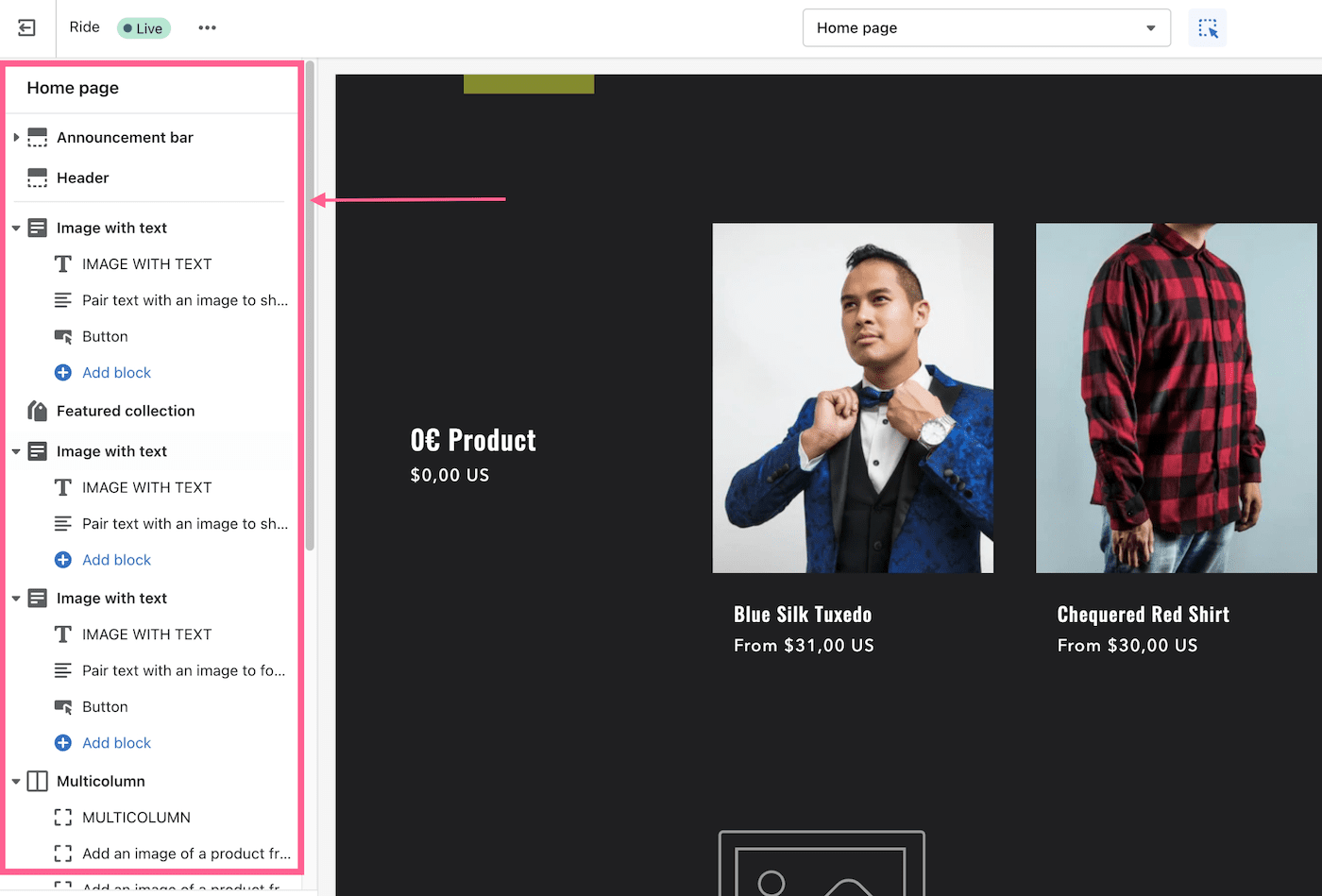
Shopify Online Store 2.0 Editor
In 2021 Shopify introduced the “Online Store 2.0”, which is essentially an upgrade to their architecture, which makes it easier for both developers to build themes and for merchants to customize them.
The most important thing here is that Online Store 2.0 gives you, as a merchant, loads more control over the appearance of your store. Most significantly, you can add drag and drop modular sections to every page.
But you can also edit metadata on a granular level, and more easily integrate apps in your storefront.
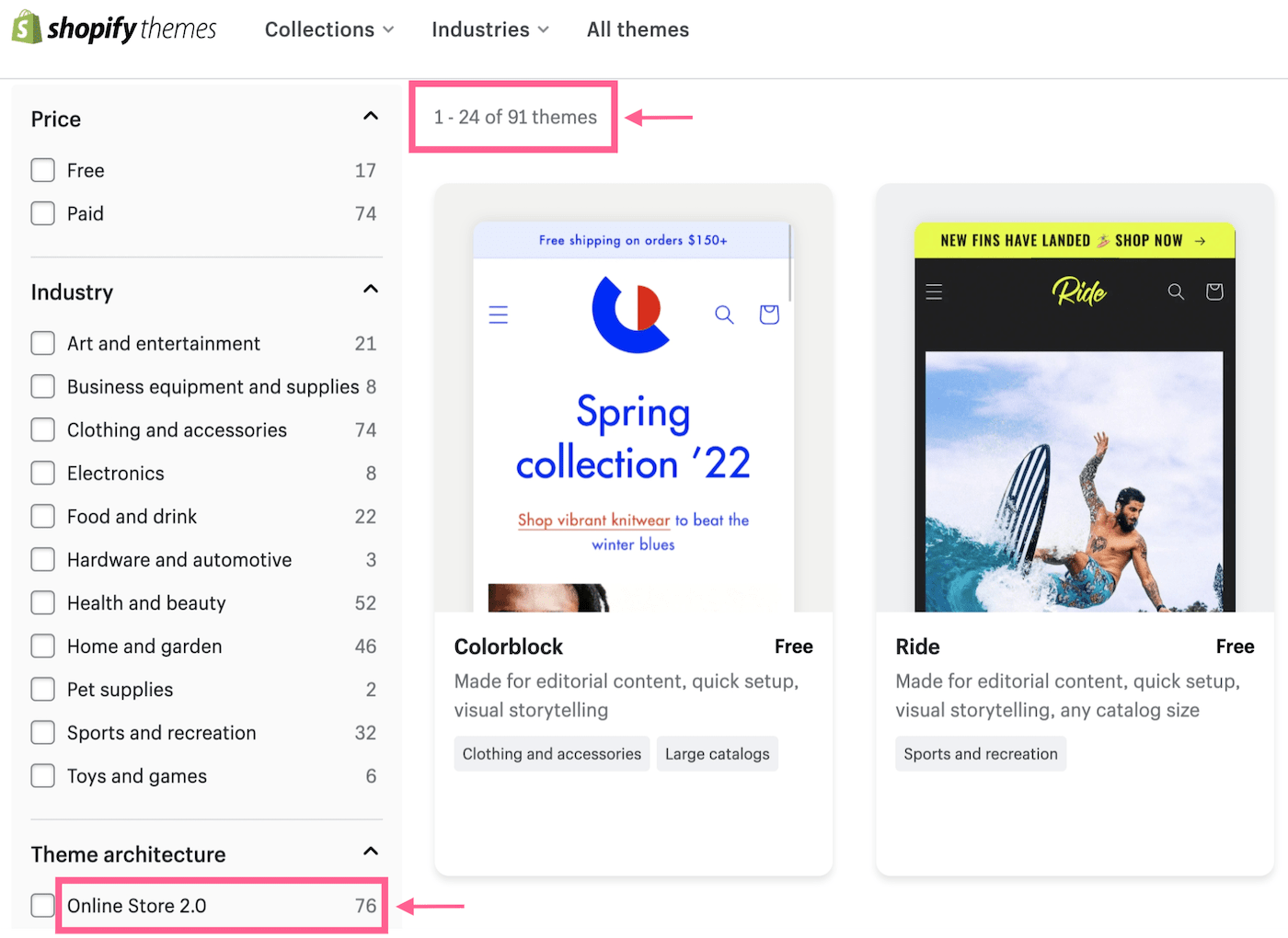
Not all the themes use the new 2.0 architecture
Not every theme is compatible with Online Store 2.0 though, and although you will be able to customize even these heritage themes, it will be much more difficult than it is with the new architecture.
Of the 17 free themes in the Shopify Store, at the time of writing, 8 of those are compatible with Online Store 2.0. However, heritage themes are being upgraded, and new themes are being released, so I would expect this number to increase.
I would therefore highly recommend that you choose an Online Store 2.0 compatible theme wherever possible.
It’s fast and responsive
With over 60% of online transactions now happening on mobile devices, it’s important that your theme loads quickly and looks good on mobiles, because if customers have to wait, they won’t convert!
All the free themes in the Shopify Theme Store are built for speed, and they’re all responsive, which means they automatically adjust their layout, so they look great on all devices and screen sizes.
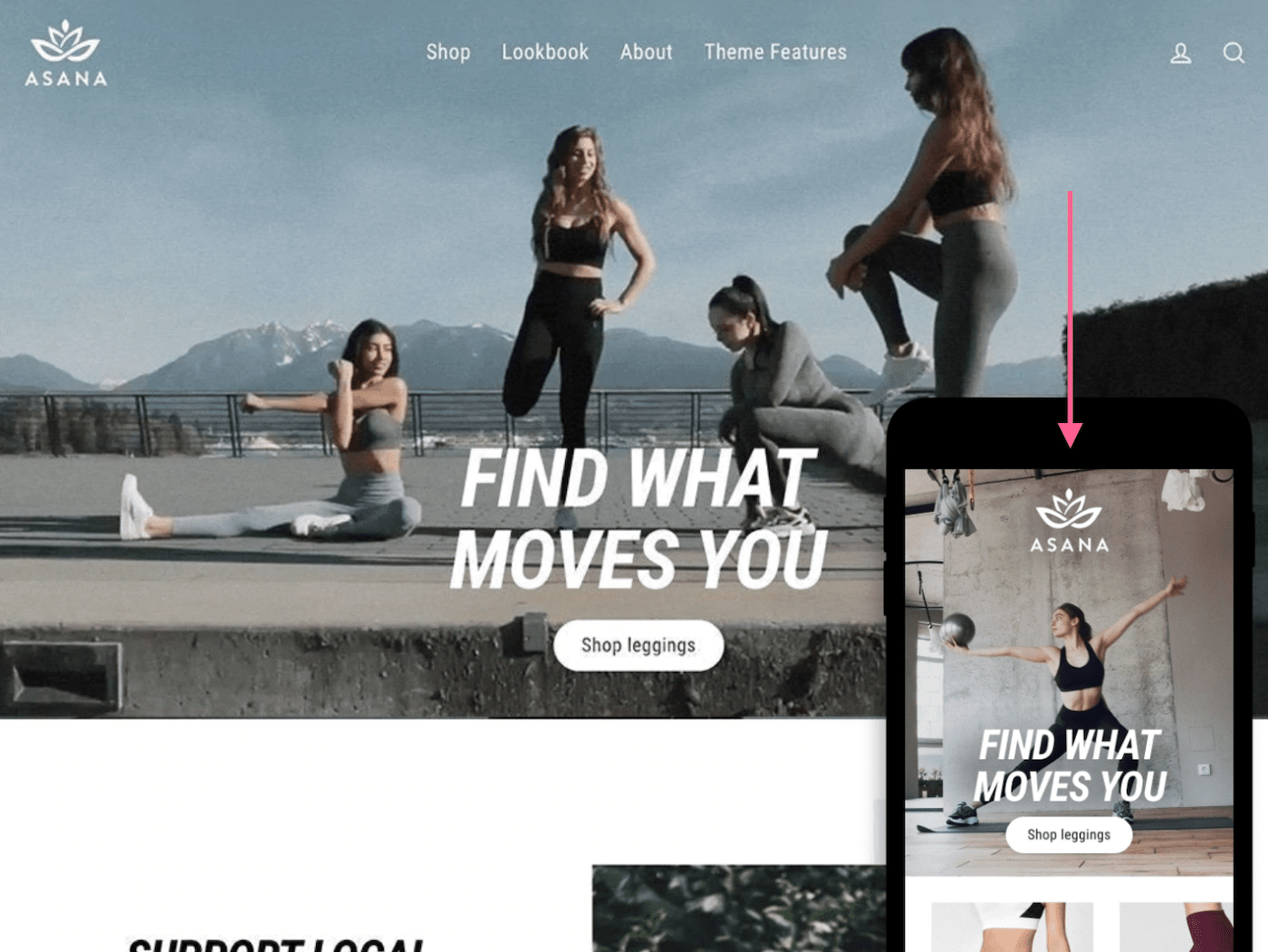
Good themes look good on all devices!
You may not get the same performance with free themes bought through other marketplaces or directly from third parties, so it’s worth testing any Shopify theme you’re considering, using tools such as Google’s Mobile Friendly Test and PageSpeed Insights.
It’s accessible
Accessible websites ensure that users with disabilities can understand the content, navigate the site, and complete tasks as well as anyone else. The accessibility of a Shopify store is largely determined by the theme, so it’s important to choose one that’s built to meet these requirements.
This isn’t just a case of doing “the right thing”, or even ensuring that you’re not losing the custom of the 15% of the population who are living with disabilities: if your website isn’t ADA compliant, you’re risking fines of up to $150,000!
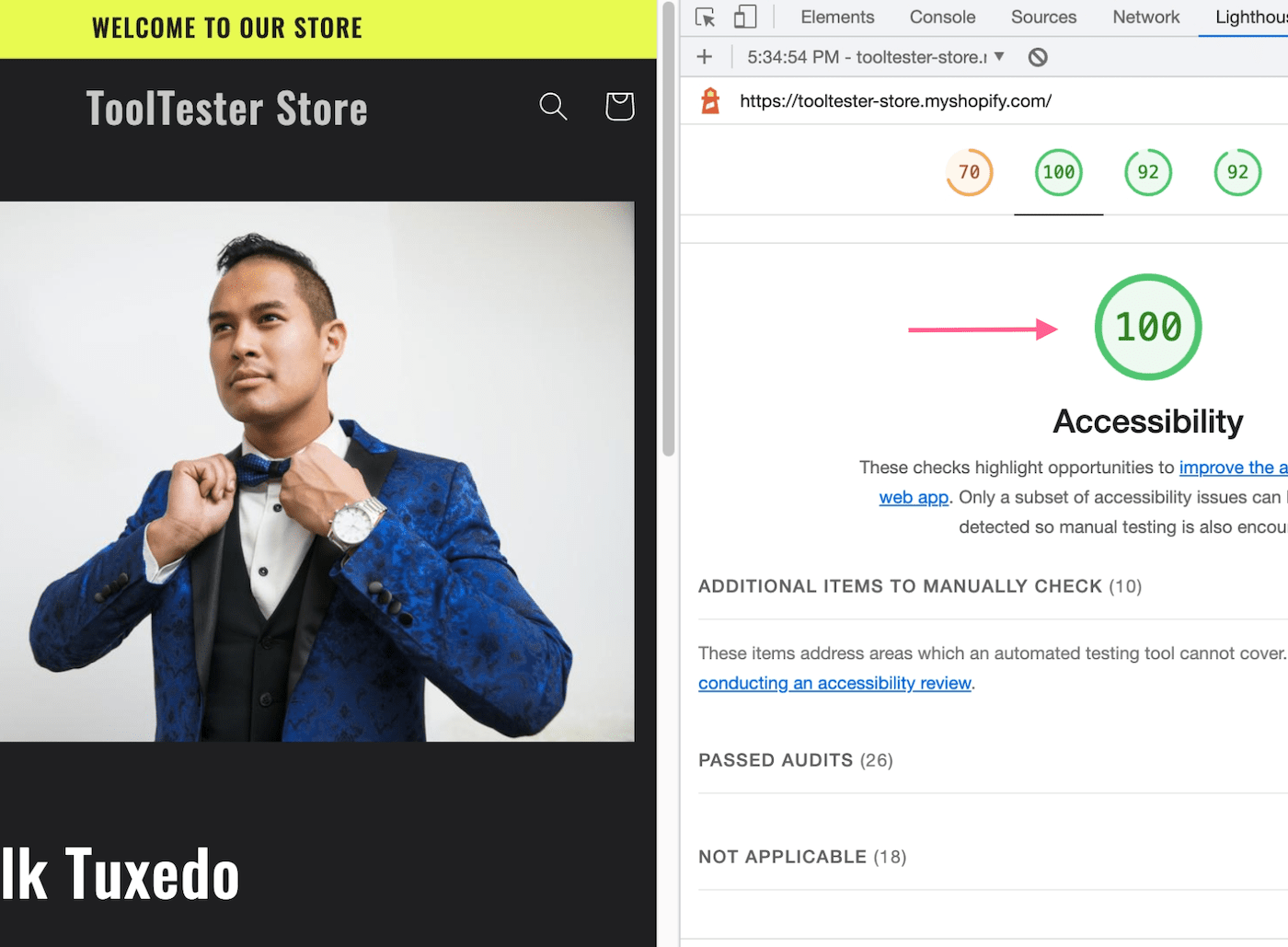
All the themes in the Shopify Store are highly accessible
Luckily, all the free and paid themes in the Shopify Theme Store meet the most up-to-date accessibility standards. However, you will need to check whether a theme from elsewhere does so.
Good customer support
You will always have questions! Make sure there is plenty of documentation, providing a deep and wide knowledge base. It’s also good to be able to communicate directly with a real person when you run into problems that the documentation doesn’t solve.
The Best Free Shopify Themes for 2022
So, now you know what a Shopify theme is, why it’s important and how to choose one, let’s take a look at the 12 best free Shopify themes available today!
1. Dawn
When you first sign up with Shopify, your default store theme will be Dawn. And there’s a good reason for this: it’s extremely slick and versatile!
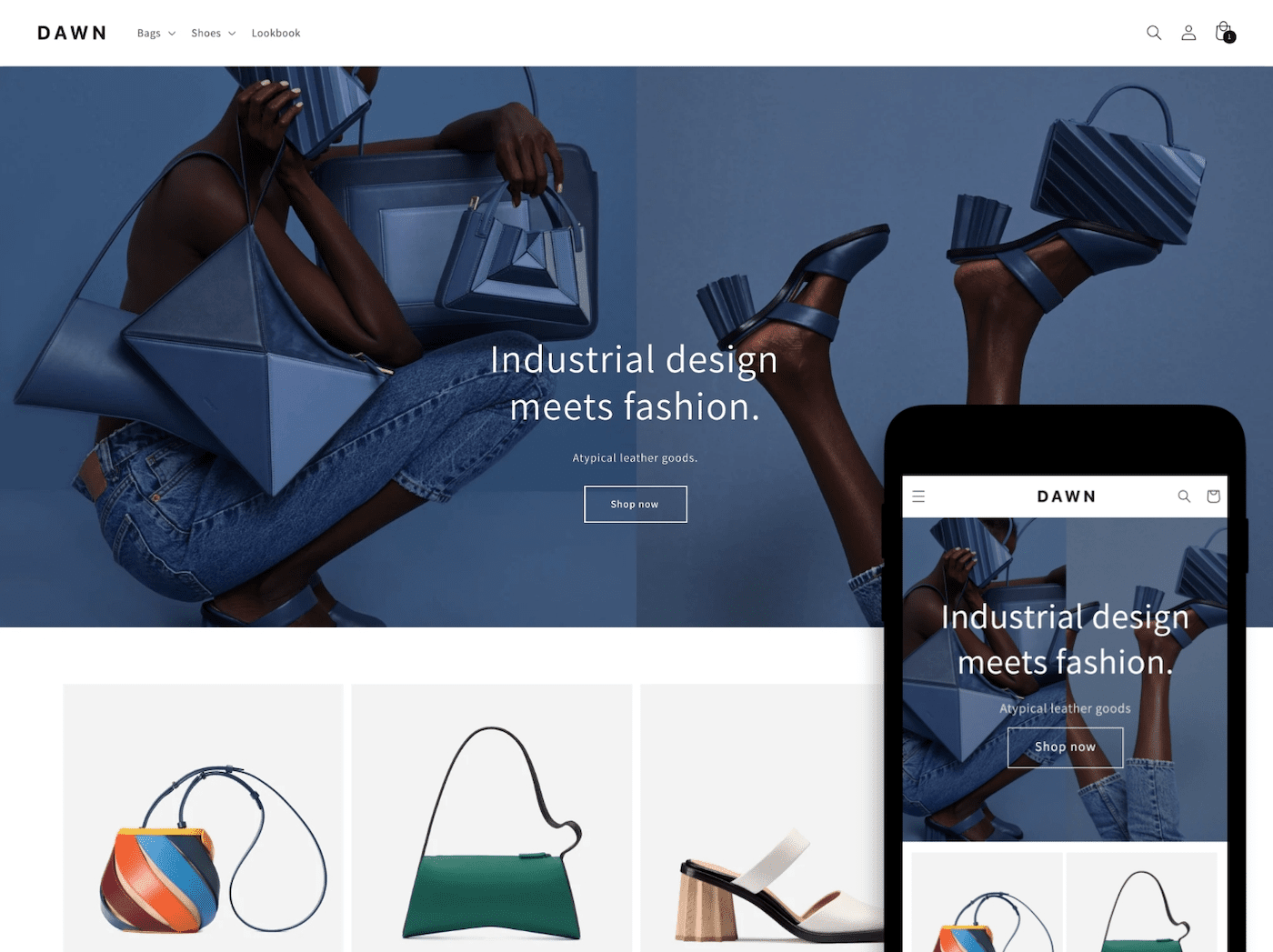
Dawn
It has a modern, minimalist look, which will really highlight your product images. But more importantly, it is one of the most customizable free Shopify Themes, so you’ll be able to make your store look exactly how you want!
- By: Shopify
- Framework: Online Store 2.0
- Recommended for: Clothing & accessories, Health & beauty, Home & Garden
- Example Stores: Olivine Atelier, Jimbobart
You can use templates with drag-and-drop sections to easily control exactly how every page should look. It features a mega menu, so it can deal with large inventories. And it has an image first feel, with high resolution images, galleries, roll-overs and zoom features.
2. Taste
It’s also quite minimal, but Taste has a slightly more forceful appearance than Dawn. The fonts are bolder, and it uses strong, sharp-edged boxes to divide the different sections. It has a slightly lo-tech, utilitarian feel to it.
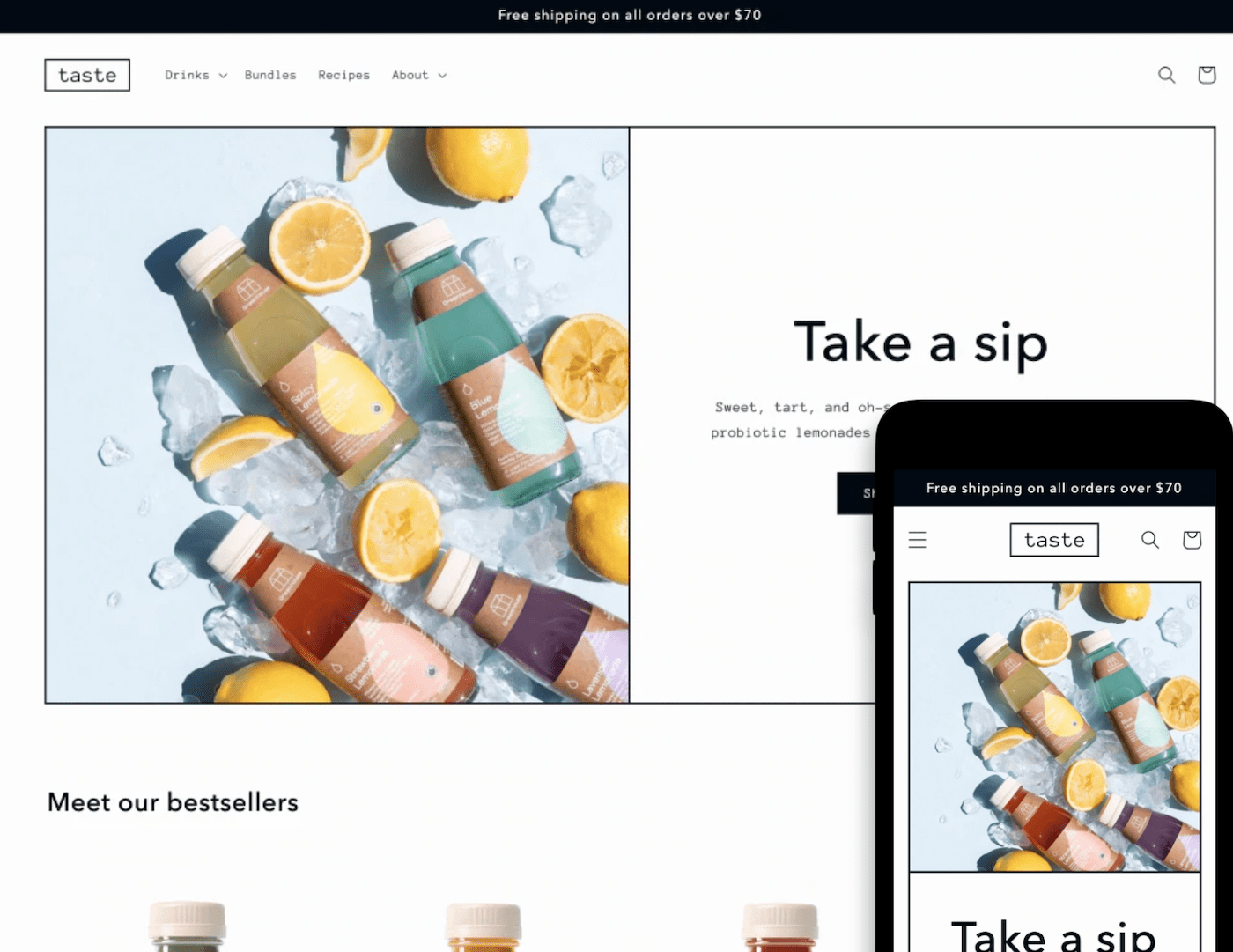
Taste
- By: Shopify
- Framework: Online Store 2.0
- Recommended for: Specialty food and drinks
3. Craft
Craft is another minimal theme, but it’s much less modern feeling than Taste or Dawn. It features a subtle, calming color palette and a refined serif fonts that convey an air of craftsmanship and quality!

Craft
Note that: unlike Taste and Dawn, you don’t get the option of a sticky header with the Craft theme.
- By: Shopify
- Framework: Online Store 2.0
- Recommended for: Home and garden
4. Colorblock
Colorblock is a visually striking theme with a strong color palette and a blocky aesthetic. The fonts are big and bold. And the mega menu and advanced product filtering options make it particularly suitable for large catalogs.
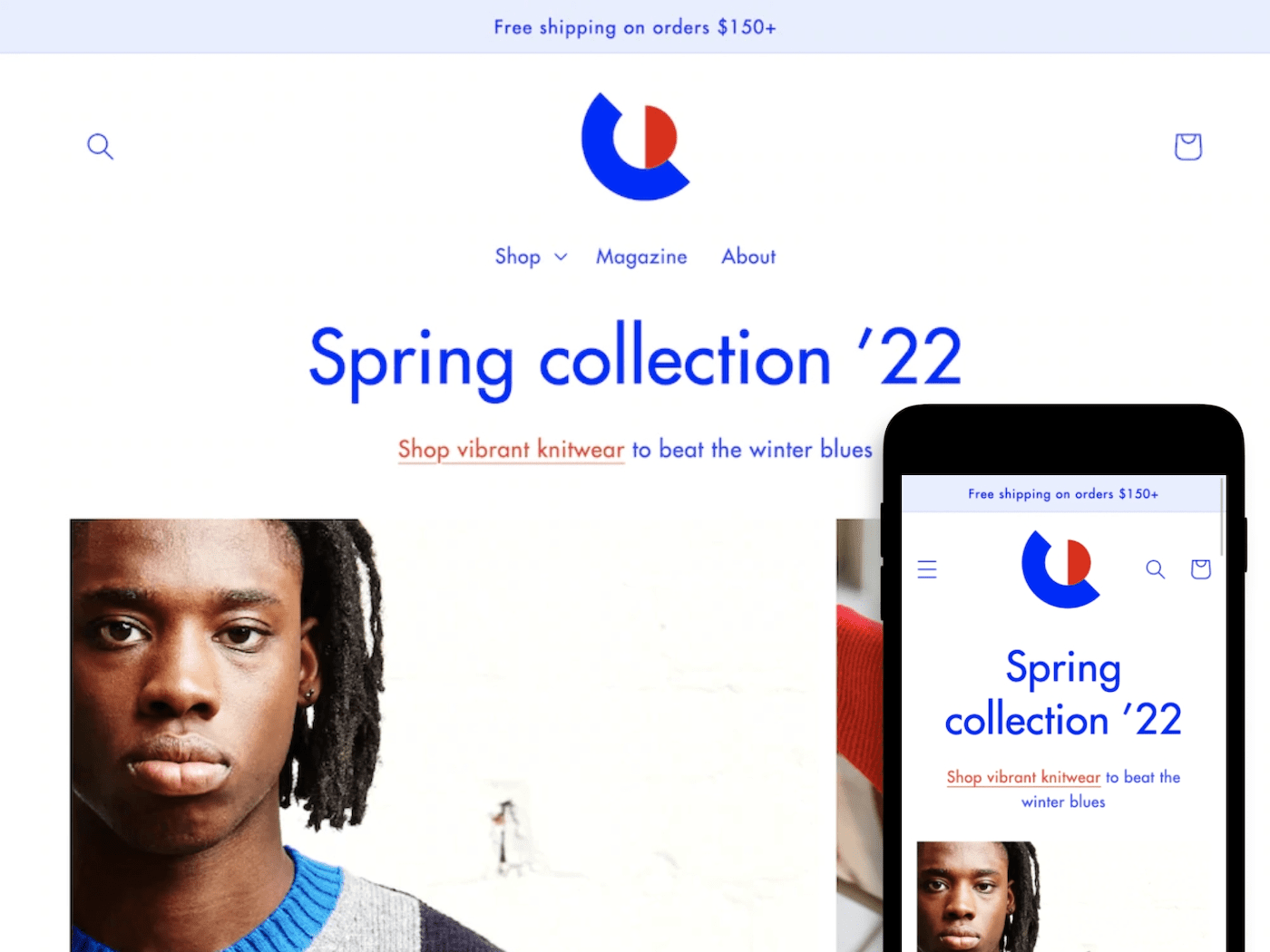
Colorblock
- By: Shopify
- Framework: Online Store 2.0
- Recommended for: Clothing and accessories
- Example Stores:
5. Studio
Studio is a particularly classy looking theme. Again, it’s quite minimal, featuring a restrained color palette and plenty of white space. It also uses a sophisticated serif font and elegantly rounded buttons, for a high class look and feel.

Studio
- By: Shopify
- Framework: Online Store 2.0
- Recommended for: Art and entertainment
6. Ride
Ride is the last of the minimal free Shopify themes. But while it does use plenty of empty space and a small color palette, it’s a very vibrant, “in your face” theme. The colors are strong, the images are big, and it has a very sporty, dynamic feel.
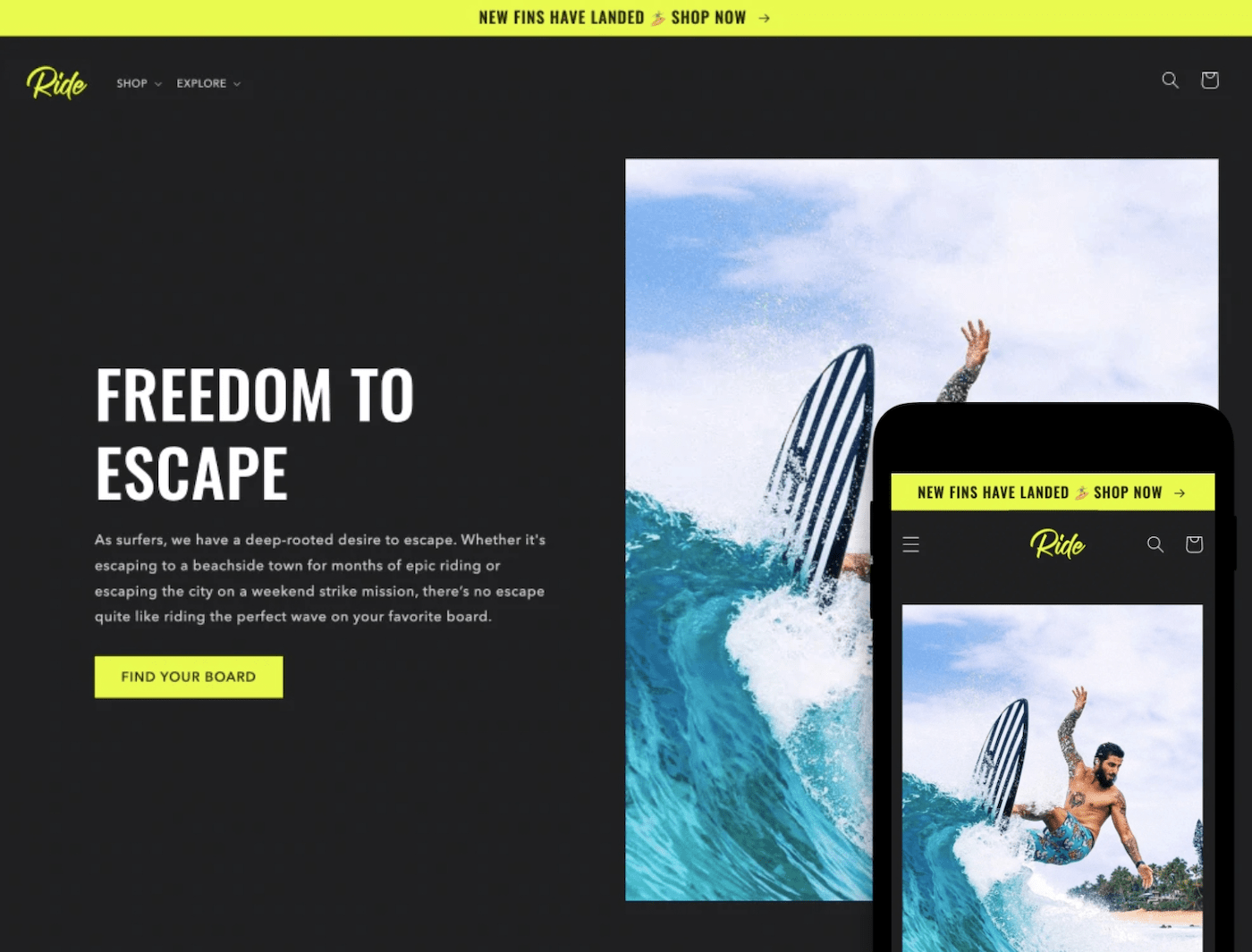
Ride
- By: Shopify
- Framework: Online Store 2.0
- Recommended for: Sports and recreation
7. Sense
Moving away from the minimal themes, Sense is much more content rich, featuring a bright color palette, full of gentle gradients and curved UI elements. It uses crisp and modern sans serif fonts to top off the fresh and lively look and feel.
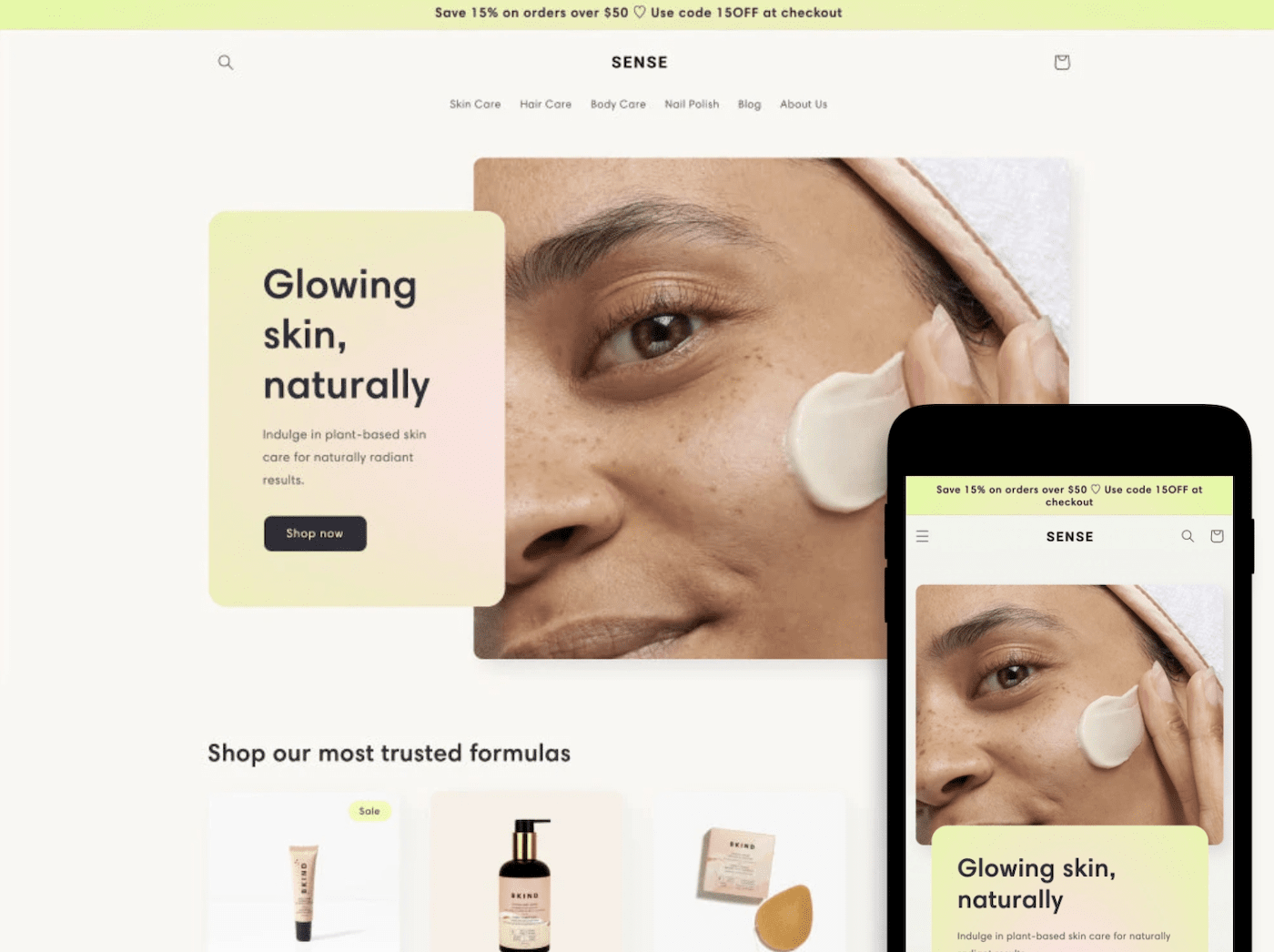
Sense
- By: Shopify
- Framework: Online Store 2.0
- Recommended for: Health and beauty
8. Crave
Crave is probably the most colorful and content rich of the free Shopify themes, featuring bold colors and strong shadows on the UI elements. It uses very distinctive serif fonts for the headers and more restrained sans serif fonts in the paragraphs for easy reading.
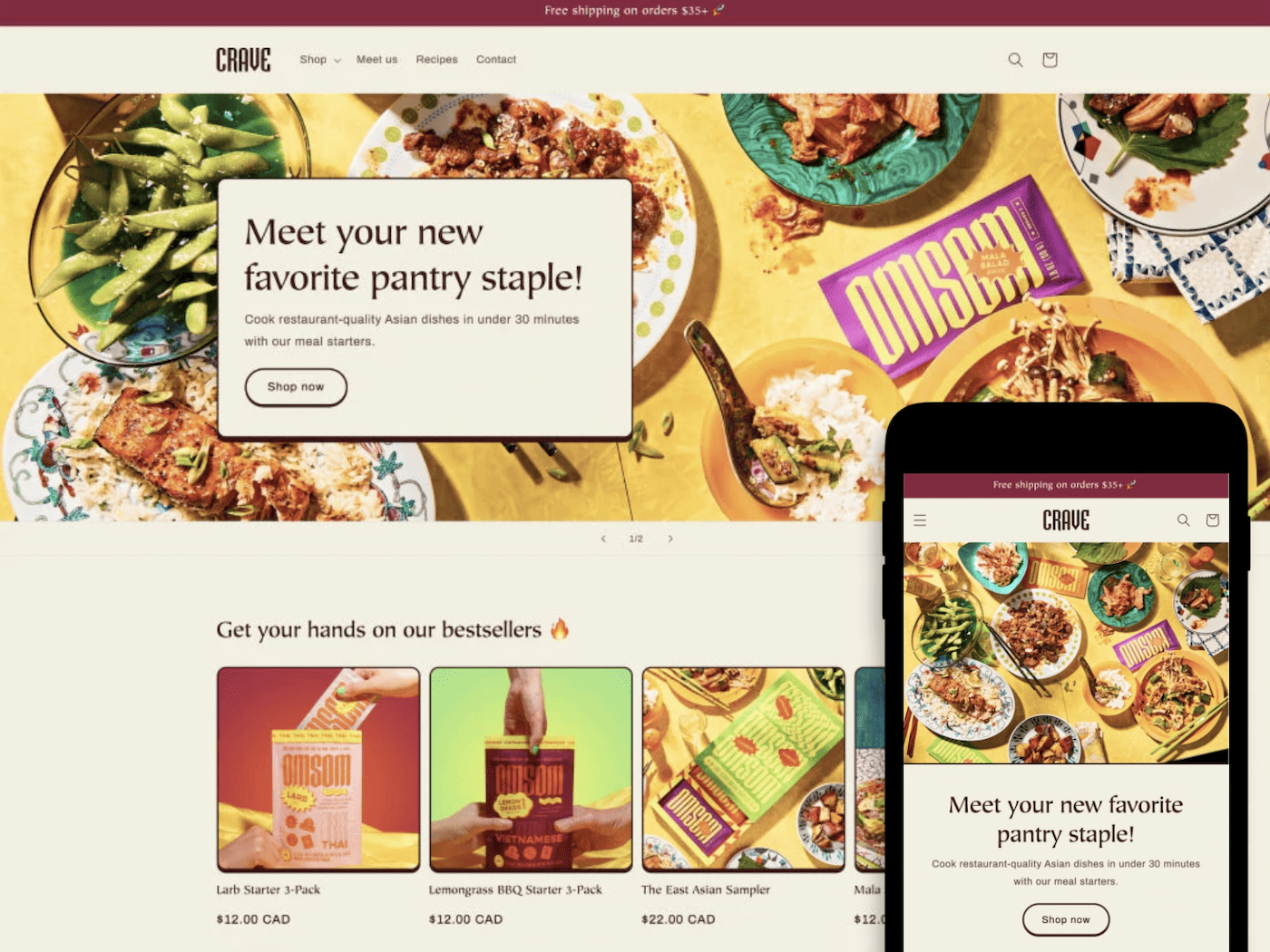
Crave
- By: Shopify
- Framework: Online Store 2.0
- Recommended for: Food and drink
9. Brooklyn
Brooklyn isn’t built with Online Store 2.0, so customizing this theme won’t be as easy as the previous examples. But if you like the design, then Brooklyn is a great example of a pretty minimalist, but still warm theme, that projects quality.
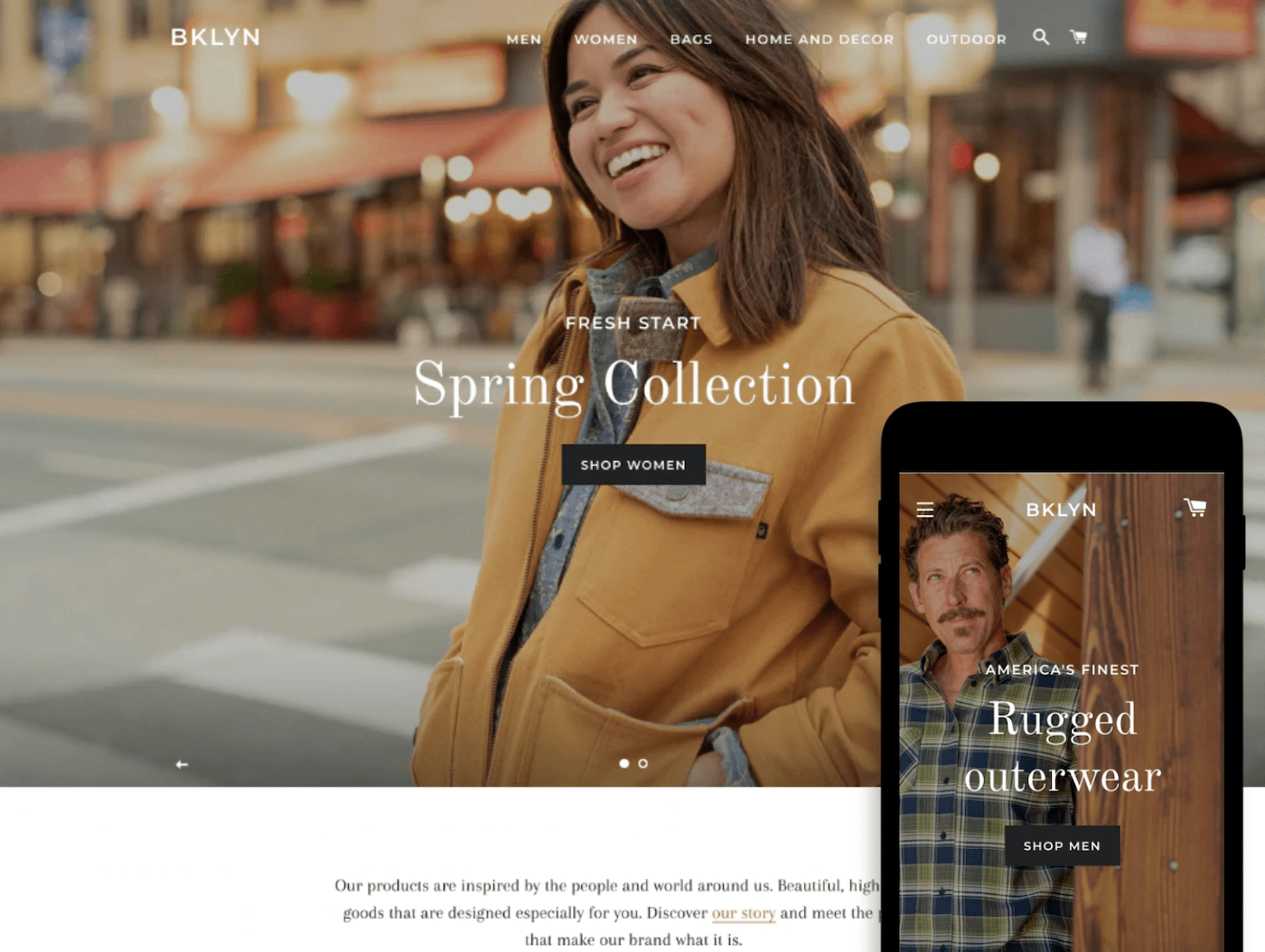
Brooklyn
It comes with two quite different design presets (Classic and Playful) and a nice slide-out cart (so customers can add to their cart without leaving the page), which is sure to boost conversions.
- By: Shopify
- Framework: Online Store 1.0
- Recommended for: Clothing and accessories
10. Minimal
Minimal is another free Shopify theme that’s built with Online Store 1.0, so again, you won’t get the easy customization options that you get with the 2.0 themes. However, Minimal is a lovely theme, with three very different design presets (Vintage, Fashion and Modern).

Minimal
- By: Shopify
- Framework: Online Store 1.0
- Recommended for: Clothing and accessories, Art and entertainment, Home and garden
11. Surprise
Surprise is the first free Shopify theme in this list that’s not developed and supported by Shopify themselves. Instead, Surprise in made by Apollo Themes who create a whole load of free and paid Shopify themes.
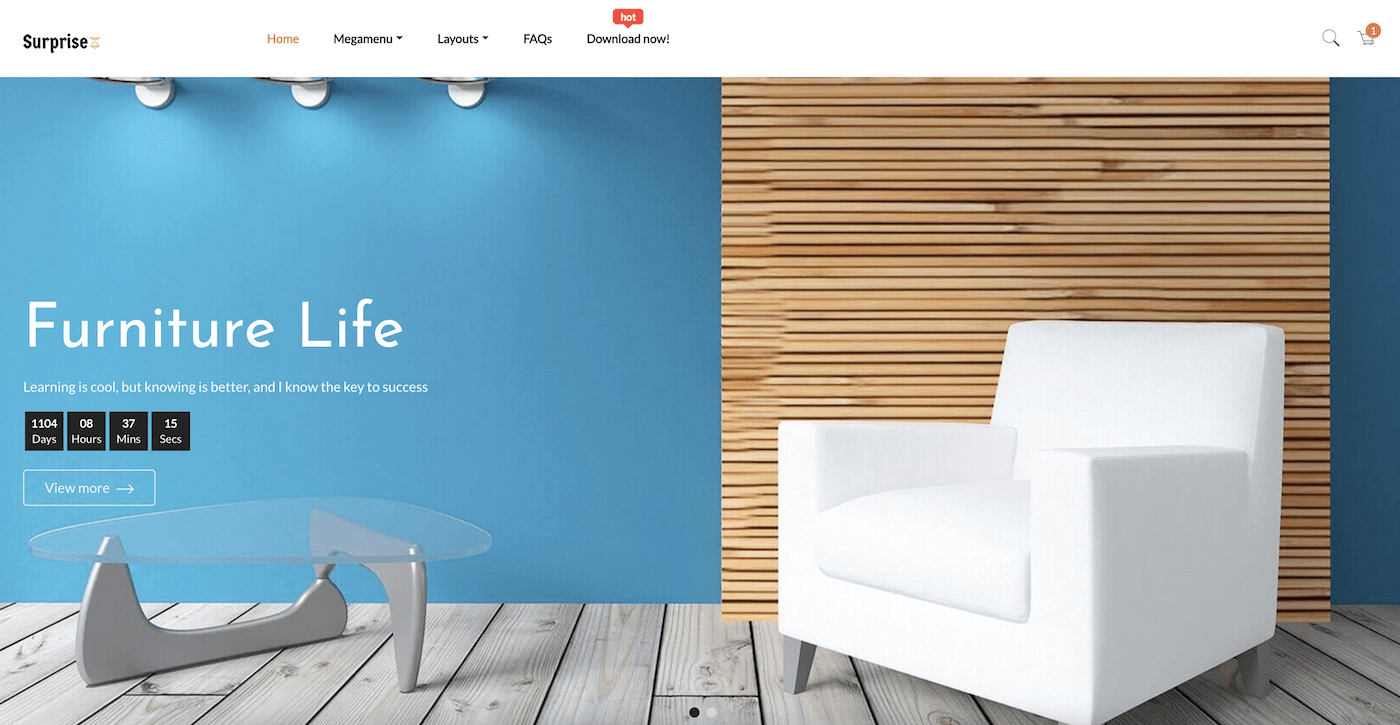
Surprise
Surprise is a built on the popular Bootstrap framework, and has some interesting features such as a powerful and flexible mega menu, a countdown timer, a popup cart etc. It’s also got a clean, modern design, which is difficult to dislike.
However, there’s also a premium paid version of this theme, with loads of features that are missing or limited in the free version, so it’s worth comparing the two before you make a decision here.
Also note that any customer support is likely to be limited in the free version of Surprise, which is not ideal.
- By: Apollo Themes
- Framework: Bootstrap 4.3.1
- Recommended for: Home and garden, Art and culture
- Example Stores:
12. Thalia
The final free Shopify theme in this list, Thalia, is made by aThemes, who are more commonly known for their WordPress themes. It’s another clean, minimalist theme that wouldn’t look out of place in the Shopify store.
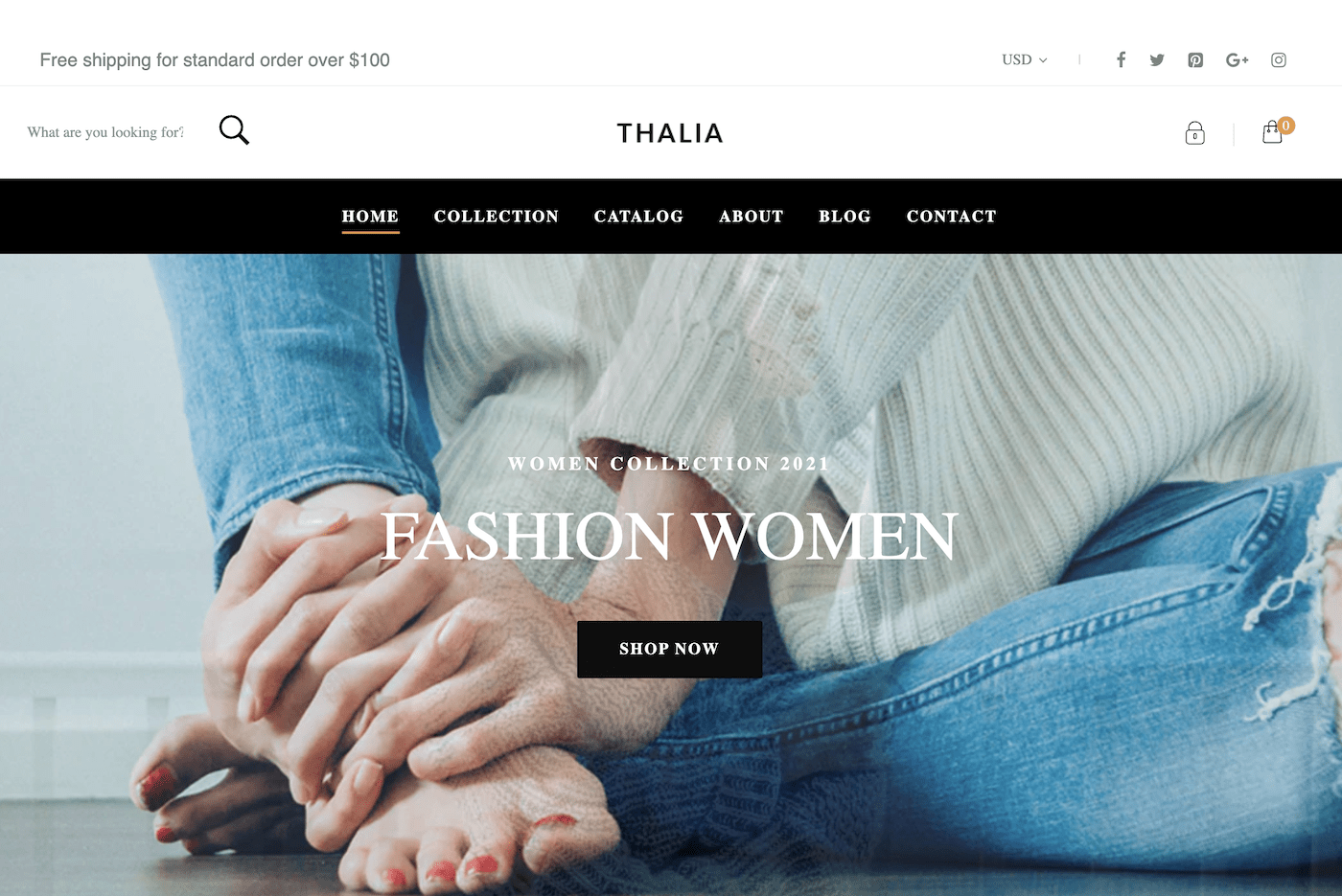
Thalia
It includes advanced collection filtering and product swatches, so is well suited to catalogs with lots of variations in their products, like fashion stores for example. And it also includes a handy slide out cart for maximum conversions!
There’s a reasonable amount of online documentation, but it’s not clear how much support you’ll get beyond that, unless you become a paid member of aThemes (probably none!).
- By: aThemes
- Framework: Bootstrap
- Recommended for: Clothing and accessories
- Example Stores:
Free Shopify Themes: A Conclusion
So there you have the best free Shopify themes available in 2022. To be honest, my recommendation is to always go for a theme from the Shopify Theme Store that’s built with Online Store 2.0.
That way, you’ll be able to take advantage of the endless and easy customization options available through the latest 2.0 architecture, you’ll get proper customer support from Shopify themselves, and you can be sure your theme won’t be discontinued anytime soon.
It’s a shame that there are only 8 such themes available at the moment, as this means you’ll be using the same theme as a lot of other stores!
However, the ability to customize your store quickly and easily means you can move away from the generic look and feel of your store whenever you want.
If you haven’t signed up for Shopify yet, and you’re still not sure about it, you can also read our comprehensive Shopify review, or see how it compares to other ecommerce website builders.
FAQs
No, changing your Shopify theme won’t break your store. The theme has nothing to do with your actual content, only the way the content is displayed. So changing themes could obviously affect the navigation and the layout of your store.
We keep our content up to date
30 Dec 2022 - Smaller updates and corrections
THE BEHIND THE SCENES OF THIS BLOG
This article has been written and researched following a precise methodology.
Our methodology